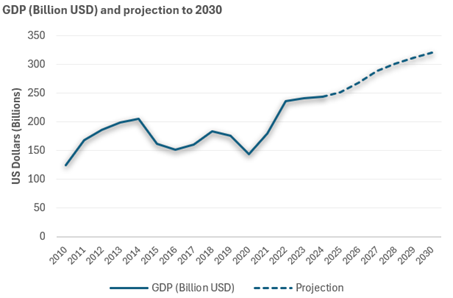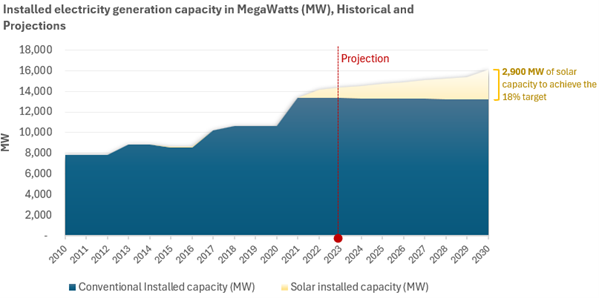I-RECs: A Catalyst for Renewable Energy Investment in Qatar
As a signatory to the Paris Agreement, the State of Qatar has reaffirmed its commitment to combating climate change by setting ambitious targets. The State aims to reduce greenhouse gas (GHG) emissions by 25% from 2010 levels and achieve an 18% share of renewable energy, primarily solar photovoltaics (PV), in its electricity generation mix by 2030. This is a significant challenge, especially given Qatar’s status as having the highest GHG emissions per capita globally.
Qatar’s economy, heavily reliant on its abundant natural gas reserves, reached a record Gross Domestic Product (GDP) of $236 billion USD in 2022, with projections suggesting growth to $320 billion USD by 2030. To accommodate this economic expansion, the Qatar National Renewable Energy Strategy (QNRES) anticipates energy demand to rise to 11,500 Megawatts (MW) by 2030, up from 9,600 MW in 2021. Consequently, the supply capacity from conventional sources is planned at 13,200 MW, necessitating approximately 2,900 MW of solar PV capacity to meet the 18% renewable energy target.


Based on IRENA’s Energy Profile for Qatar, the average solar PV potential is 1.7975 MWh/KWp annually. This means that the 2,900 MW of solar PV capacity could generate around 5.2 TWh of electricity each year from 2030 onwards, equivalent to 5.2 million International Renewable Energy Certificates (I-RECs).
I-RECs are Environmental Attribute Certificates (EACs) that represent the environmental attributes of electricity generated from renewable resources. They are issued by certified issuers accredited by the International Tracking Standard Foundation (ITS), ensuring transparency and credibility. Each I-REC represents 1 megawatt-hour (MWh) of renewable electricity, providing detailed information about its origin, technology, region, and vintage.
Qatar’s anticipated economic growth over the next five years is expected to attract significant investments, with many international companies eager to contribute to and benefit from this growth. Aligning this economic expansion with global corporate initiatives like RE100, which aims for 100% renewable electricity procurement by 2050, could further boost investments in solar PV in Qatar. RE100 has attracted a significant number of leading businesses, including industry giants like Apple, Google, Intel, 3M, and many others. As the global push for net-zero emissions and renewable energy adoption intensifies, the demand for I-RECs has surged. Since 2020, the annual growth rate of I-REC issuance has been an impressive 100%, underscoring the increasing importance of this tool in the transition to a sustainable energy future.
REC Market Development in Qatar
To fully leverage the benefits of Renewable Energy Certificates (RECs), Qatar can implement several strategic steps to develop a robust REC market:
- Establish a Clear Regulatory Framework: A transparent and well-defined regulatory framework is crucial for the successful development of a REC market. This framework should outline the rules and guidelines for REC issuance, trading, and compliance.
- Promote REC Trading: The government can foster REC trading by setting up a REC registry and facilitating transactions. This can be achieved through various initiatives, such as creating an online platform for REC trading and providing incentives for market participants.
- Incentivize REC Purchases: Government agencies and businesses can be encouraged to purchase RECs through financial incentives, tax benefits, or recognition programs. These incentives can drive demand for RECs and support the growth of renewable energy projects.
- Educate the Public: Raising awareness about the benefits of RECs and how they contribute to renewable energy development is essential. Public education campaigns can help increase participation in the REC market and promote a culture of sustainability.
RECs present a valuable tool for Qatar to accelerate its progress towards its renewable energy targets and ambitious climate goals. By developing a robust REC market, Qatar can stimulate investment in renewable energy, encourage consumer adoption, and effectively track progress towards its sustainability objectives. This strategic approach will not only help Qatar meet its environmental commitments but also position the country as a leader in the global transition to a sustainable energy future.
Data Sources
- Qatar National Renewable Energy Strategy (QNRES), Qatar General Electricity and Water Corporation (KAHRAMAA).
- https://tradingeconomics.com/qatar/gdp#:~:text=GDP%20in%20Qatar%20averaged%2055.93,statistics%2C%20economic%20calendar%20and%20news
- https://www.statista.com/statistics/379978/gross-domestic-product-gdp-in-qatar/
- International Renewable Energy Agency (IRENA): Energy Profile, Qatar. (https://www.irena.org/



